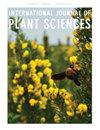First Fossil Mallow Flower from Asia
IF 1.5
3区 生物学
Q3 PLANT SCIENCES
引用次数: 0
Abstract
Premise of research. Malvaceae, or the mallows, are well known from the Cenozoic sediments of Asia and are represented by many fossil leaves, woods, fruits, and pollen. Until now, no fossil flower of Malvaceae has been reported from the Cenozoic sediments of Asia. The present study addresses this lacuna and documents the evidence of mallow fossil flowers from Asia for the first time. Methodology. Fossil flowers similar to modern flowers of Bombax L. (Malvaceae) were recovered from the latest Neogene (Pliocene) sediments of Chotanagpur Plateau, Jharkhand, eastern India. They were revealed by careful removal of the overlying matrix and studied under light microscopy. Pivotal results. The fossil flowers, characterized by irregularly lobed sepals, obovate-elliptic petals, numerous stamens bearing long filaments, and characteristic reniform anthers, are recognized as a new species, Bombax asiatica Hazra, Bera et Khan sp. nov. A morphological principal coordinates analysis and cladistic parsimony analysis based on floral morphological characters support this taxonomic assignment. Conclusions. This fossil evidence provides an important clue about the past diversity and paleobiogeography of the mallow family in the Indian Cenozoic. This finding and earlier reported Malvaceae fossils from the same locality also indicate the presence of tropical climate in Jharkhand, eastern India, during the time of deposition.亚洲第一个锦葵花化石
研究的前提。Malvaceae,或称malmall,在亚洲的新生代沉积物中很有名,以许多树叶、树木、果实和花粉的化石为代表。到目前为止,在亚洲新生代沉积物中还没有发现锦葵科花的化石。本研究填补了这一空白,并首次记录了亚洲锦葵花化石的证据。方法。在印度东部贾坎德邦乔塔纳格布尔高原新近纪(上新世)沉积物中发现了类似于Bombax L. (Malvaceae)现代花的化石。通过仔细去除覆盖的基质,并在光学显微镜下研究了它们。关键的结果。Bombax asiatica Hazra, Bera et Khan sp. 11 .该花化石具有萼片不规则浅裂、花瓣倒卵形椭圆形、大量雄蕊长花丝、肾形花药等特征,是一个新种。基于花形态特征的形态主坐标分析和枝系简化分析支持了这一分类定位。结论。这一化石证据为研究印度新生代锦葵科过去的多样性和古生物地理提供了重要线索。这一发现和早期报道的来自同一地点的Malvaceae化石也表明,在沉积时期,印度东部的贾坎德邦存在热带气候。
本文章由计算机程序翻译,如有差异,请以英文原文为准。
求助全文
约1分钟内获得全文
求助全文
来源期刊
CiteScore
4.50
自引率
4.30%
发文量
65
审稿时长
6-12 weeks
期刊介绍:
The International Journal of Plant Sciences has a distinguished history of publishing research in the plant sciences since 1875. IJPS presents high quality, original, peer-reviewed research from laboratories around the world in all areas of the plant sciences. Topics covered range from genetics and genomics, developmental and cell biology, biochemistry and physiology, to morphology and anatomy, systematics, evolution, paleobotany, plant-microbe interactions, and ecology. IJPS does NOT publish papers on agriculture or crop improvement. In addition to full-length research papers, IJPS publishes review articles, including the open access Coulter Reviews, rapid communications, and perspectives. IJPS welcomes contributions that present evaluations and new perspectives on areas of current interest in plant biology. IJPS publishes nine issues per year and regularly features special issues on topics of particular interest, including new and exciting research originally presented at major botanical conferences.

 求助内容:
求助内容: 应助结果提醒方式:
应助结果提醒方式:


